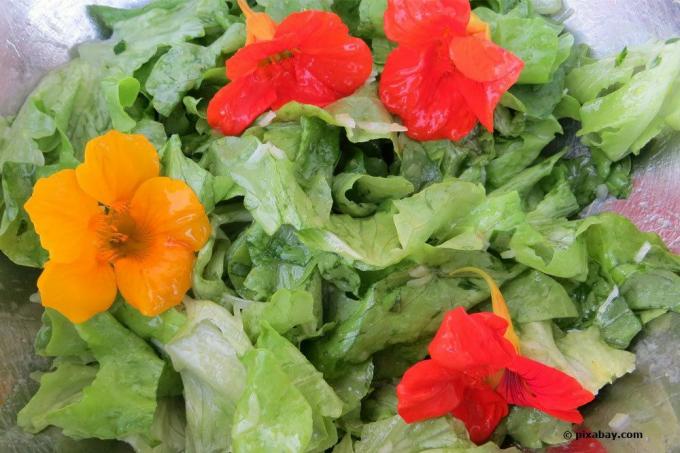
table of contents
- Toxic or not
- The taste
- Health promoting properties
Anything that tastes hot, bitter or otherwise “extreme” is quickly classified as inedible or even poisonous. Because in fact, poisonous plants usually signal the dangerous ingredients through their taste. But is the nasturtium poisonous too? Or isn't the decorative plant edible after all?
Toxic or not
The South American blood flower is particularly popular because of its bright, large-format flowers. Whether in the garden, on the balcony or on the windowsill at home, it delights countless hobby gardeners. But hobby cooks also benefit from it. Because the decorative flowers are particularly popular in the kitchen to decorate salads with intense splashes of color, to garnish desserts or to enhance other dishes. Therefore, you can safely assume that Tropaeolum should at least not be so dangerous that it can harm people.
This assessment is exactly correct, because in fact not only the decorative flower arrangements can be eaten safely. In addition, all components of the nasturtium are non-poisonous and therefore edible:
- root
- Stems
- leaves
- blossoms
NOTE: In Peru, the homeland of the nasturtium, the tuberous thickened roots of the tuberous nasturtium Tropaeolum tuberosum are even specifically cultivated and harvested. Similar to potatoes, they can be cooked or roasted and consumed whole or as a porridge. It used to be a staple food for the indigenous tribes.
The taste
In principle, of course, edibility is defined according to whether a plant is toxic or medically harmless. In addition, the taste also determines whether a plant can actually earn a position as a food. Various descriptions by testers, cooks and gardeners result in a round taste profile with the following properties:
- Spicy
- Slightly sharp
- Similar to the rocket (both Cruciferous plants)
The spiciness is mainly due to the mustard oils it contains. This substance, which the nasturtium actually contains as a protective mechanism, is completely harmless to humans and even rounds off the portfolio of valuable content. In addition to mustard oils, it also contains these other substances:
- Vitamins, especially vitamin C.
- Minerals
- Trace elements

NOTE: Originally, mustard oil is contained in the intact plant as mustard oil glycoside. Only when the cells are destroyed by tearing, chewing, etc. the substance reacts with the also contained enzyme myosinase to form mustard oil. It is the oil itself that creates the pungent taste. Although this is irrelevant for the eater, one could say that the nasturtium only becomes spicy when it is eaten.
Health promoting properties
Sometimes the nasturtium is even described as a medicinal plant. Because the combination of ingredients is said to have numerous positive effects on the human organism, which have now been repeatedly medically proven:
- Promote blood circulation
- Stimulates appetite and digestion
- Promote blood purification
- Stimulation of all organs
- Mustard oil has an antibiotic effect against bacteria, viruses and fungi
However, the active ingredients of nasturtiums can now be obtained much more easily in other ways, so that it is disappearing more and more as a common remedy and at most it still plays a role in naturopathy plays.



